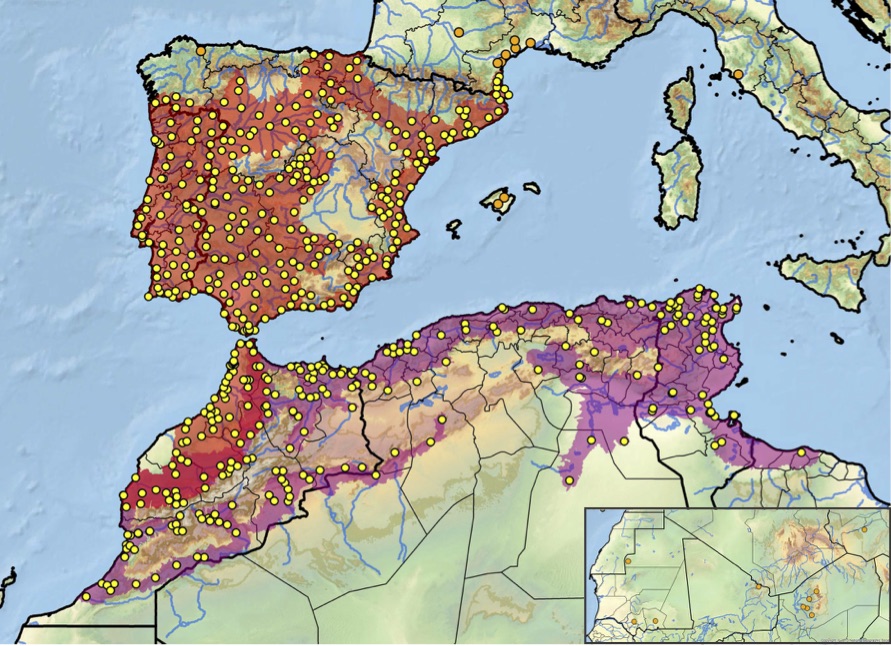Mauremys leprosa, 102
Mauremys leprosa (Schoepff in Schweigger 1812) –
Mediterranean Pond Turtle, Spanish Terrapin,
Mediterranean Stripe-necked Terrapin
Albert Bertolero1 and Stephen D. Busack2,3
1Associació Ornitològica Picampall de les Terres de l’Ebre, La Galera 53, 43870 Amposta, Spain [[email protected]];
2North Carolina Museum of Natural Sciences, Raleigh, North Carolina 27601 USA;
3Carnegie Museum of Natural History, Pittsburgh, Pennsylvania 15213 USA [[email protected]]
Summary. – The Mediterranean Pond Turtle, Mauremys leprosa (Family Geoemydidae) is a small to medium-sized freshwater turtle (carapace length up to ca. 210 mm in males, 240 mm in females), widely distributed in North Africa and across the Strait of Gibraltar to the Iberian Peninsula and southern France. Our current understanding of the species’ evolutionary history involves complex patterns of population origination, dispersion, extinction, evolution into two major lineages (each with three sublineages), and human-assisted transport. Populations in North Africa are often isolated from one another by intervening arid terrain, and a complex pattern of local variation in shell markings has occurred. Mauremys leprosa tolerates salt water, and has a high tolerance for polluted freshwater habitats, reduced water levels, and elevated ambient temperatures; carnivorous by preference, it will also feed freely upon vegetation and has been reported ingesting nitrogenous animal and human waste. Nesting occurs once annually in most populations, with mean clutch size ranging from 3.8 to 9.6 eggs, depending on the population, with the incubation period also variable, from 55–108 days in Europe to 25–30 days in Africa, the shorter period there perhaps as a response to irregular and brief pluvial periods under very arid conditions.
Distribution. – Algeria, France, Libya, Mauritania, Morocco, Niger, Portugal, Spain, Tunisia. Occurs widely across northwestern Africa and the Iberian Peninsula into southern France; scattered populations across the Saharan region may represent prehistoric introductions.
Synonymy. – Emys leprosa Schoepff in Schweigger 1812, Clemmys (Clemmys) leprosa, Clemmys leprosa, Emys caspica leprosa, Clemmys caspica leprosa, Mauremys caspica leprosa, Mauremys leprosa, Mauremys leprosa leprosa, Emys lutescens Schweigger 1812, Clemmys (Clemmys) lutescens, Clemmys lutescens, Emys marmorea Spix 1824, Clemmys marmorea, Clemmys sigriz Michahelles 1829, Terrapene sigriz, Emys sigriz, Clemmys caspica sigriz, Emys vulgaris Gray 1830, Emys sigritzii Michahelles in Gray 1831 (nomen novum), Emys laticeps Gray 1854, Clemmys laticeps, Eryma laticeps, Emys fuliginosus Gray 1860, Emys fuliginosa, Clemmys fuliginosa, Mauremys fuliginosa, Mauremys laniaria Gray 1869a, Emys flavipes Gray 1869b, Emys fraseri Gray 1869b (partim, nomen dubium), Mauremys leprosa atlantica Schleich 1996, Mauremys leprosa erhardi Schleich 1996, Mauremys leprosa marokkensis Schleich 1996, Mauremys leprosa wernerkaestlei Schleich 1996.
Subspecies. – Two are currently recognized: 1) Mauremys leprosa leprosa (Mediterranean Pond Turtle) (distribution: from northwestern Morocco through the Iberian Peninsula to southern France); 2) Mauremys leprosa saharica (Saharan Pond Turtle) (distribution: from southern and eastern Morocco through Algeria to northwest Libya, with scattered populations in the Saharan region) (synonymy: Mauremys leprosa saharica Schleich 1996, Mauremys leprosa zizi Schleich 1996, Mauremys leprosa vanmeerhaeghei Bour and Maran 1999).
Status. – IUCN 2017 Red List: Global: Least Concern [Not Listed] (LC, assessed 1996); Regional: Europe: Vulnerable (VU A2ac+3c, assessed 2004); TFTSG Draft Red List: Vulnerable (VU, assessed 2011); CITES: Not Listed; European Commission for the Environment, Birds and Habitats Directive: Annexes II and IV; Berne Convention on the Conservation of European Wildlife and Natural Habitats: Annex II.
Citation:
Bertolero, A. and Busack, S.D. 2017. Mauremys leprosa (Schoepff in Schweigger 1812) – Mediterranean Pond Turtle, Spanish Terrapin, Mediterranean Stripe-necked Terrapin. In: Rhodin, A.G.J., Iverson, J.B., van Dijk, P.P., Buhlmann, K.A., Pritchard, P.C.H., and Mittermeier, R.A. (Eds.). Conservation Biology of Freshwater Turtles and Tortoises: A Compilation Project of the IUCN/SSC Tortoise and Freshwater Turtle Specialist Group. Chelonian Research Monographs 5(10):102.1–19. doi: 10.3854/crm.5.102.leprosa.v1.2017; iucn-tftsg.org/cbftt/.
(Adobe Acrobat 6.0 or later required)

Juvenile Mauremys leprosa leprosa, Flix, Catalonia, Spain.
Photo by Albert Bertolero.
Distribution:

Historic distribution of Mauremys leprosa in southwestern Europe and northwestern Africa; inset shows Saharan region. Yellow dots = museum and literature occurrence records of native populations based on Iverson (1992) and other sources (Malkmus 1990; Fahd and Pleguezuelos 1996; da Silva 2002; Araújo and Segurado 2008; Hernández Socias 2009; Ihobe 2009; Martín i Pérez 2011; Buenetxea et al. 2011; Trape et al. 2012; Alarcos et al. 2013; Salvador and Pleguezuelos 2013; Díaz-Paniagua and Andreu 2014; Panzeri et al. 2014; Franch et al 2015; Palacios et al. 2015; Sacco 2015; Mediani et al. 2015; Héritier et al. 2017); orange dots = introduced or historically relict populations; red shading = projected historic distribution of M. l. leprosa; purple shading = M. l. saharica; overlap (dark red shading) = intergrades. Distribution based on GIS-defined level 10 HUCs (hydrologic unit compartments) constructed around verified localities and then adding HUCs that connect known point localities in the same watershed or physiographic region, and similar habitats and elevations as verified HUCs (Buhlmann et al. 2009; TTWG 2014, 2017), and adjusted based on data from authors and other sources.








